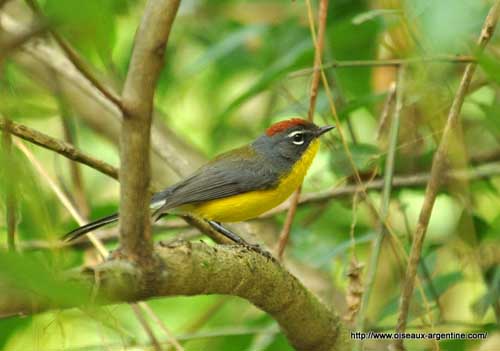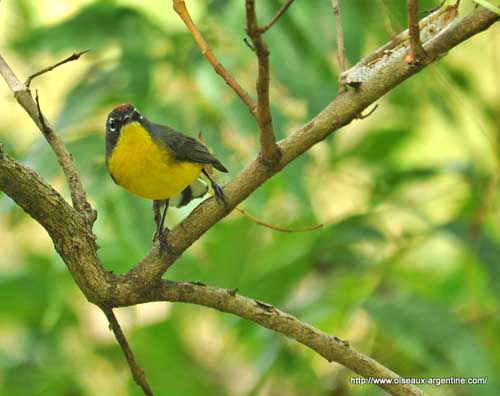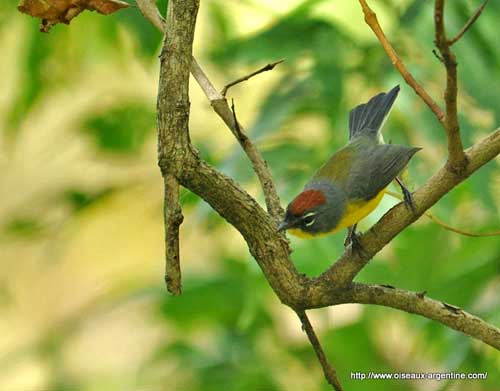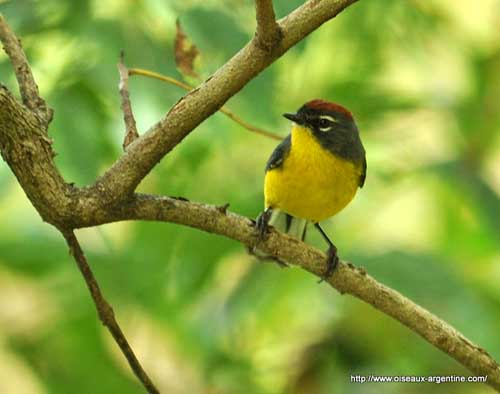
Fr: Paruline basanée
All : Braunkappen-Waldsänger
Esp: Candelita Gorjeadora
Ital: Parula pigliamosche capobruno
Nd: Bruinkapzanger
Sd: Brunkronad vitstjärt
Port: Mariquita-de-cabeça-parda
Photographers:
Philippe et Aline Wolfer
GALERIE
Text by Nicole Bouglouan
Sources:
HANDBOOK OF THE BIRDS OF THE WORLD Vol 16 by Josep del Hoyo- Andrew Elliot-David Christie – Lynx Edicions – ISBN: 9788496553781
BIRDS OF SOUTH AMERICA – Passerines - by Robert S. Ridgely and Guy Tudor – HELM Field Guides – ISBN: 9781408113424
BirdLife International (BirdLife International)
Wikipedia, the free encyclopaedia
Brown-capped Whitestart
Myioborus brunniceps
Passeriforme Order – Parulidae Family
BIOMETRICS:
Length: 13 cm
Weight: 8,5-10 g
DESCRIPTION:
The Brown-capped Whitestart is a species of humid southern Andean forests and woodlands.
The adult has grey upperparts with olive patch on mantle. The tail is blackish with largely white outer rectrices.
The underparts are yellow with white undertail-coverts.
On the grey head, we can see a conspicuous rufous crown patch. There are white crescents above and below the eye, and an indistinct whitish supraloral stripe.
Bill, legs and feet are blackish. The eyes are dark brown.
Both sexes are similar. As they pair for life, a strong sexual dimorphism is not necessary.

The juvenile has brownish-grey head and upperparts. On the underparts, throat and breast are buffy-brown, sometimes with darker spots. The lower underparts are yellow.
VOICE: SOUNDS BY XENO-CANTO
The Brown-capped Whitestart’s song is a fast, sibilant trill with slight crescendo, similar to that of Blackpoll Warbler “sit-sit-sit-sit-sit-…”
The call is a “check” or “tchip” repeated note. When the bird is excited or alarmed, these calls extend into monotone rattle.
HABITAT:
The Brown-capped Whitestart is usually common in montane forest, woodland, edges and shrubby clearings in the Andes. According to the range, this species is visible between 500 and 3000 metres of elevation.
It frequents dry deciduous forest in Bolivia, but it also occurs in humid forests farther South. This species is closely tied to woodland and forest habitats at all seasons.
RANGE:
The Brown-capped Whitestart is found in C Bolivia, southwards on E slope of the Andes to NC Argentina.

BEHAVIOUR:
The Brown-capped Whitestart is mainly an insect-eater, but it probably takes other arthropods too.
It is often very active, gleaning at low to middle level, foraging in shrubs and bushes. It moves quickly among the vegetation, searching for invertebrates in bark crevices or catching insects while flying.
It is territorial and chases away other bird species, although it may tolerate some other Parulidae such as the Tropical Parula.
The whitestarts usually flick their wings and fan the tail while foraging. This behaviour is probably used to disturb invertebrates and flushing them, making them easier to catch. It often pursues preys in short aerial sally.
The Brown-capped Whitestart usually pairs for life, remaining on or near the territory all year round.
Courtship behaviour is little known. However, various displays involve spreading of wings and fanning of tail in front of the female, in order to expose the white parts of rectrices. These white outer tail feathers are a typical feature of all whitestarts.
During the displays, the conspicuous white eye-crescents and the rufous crown are enhanced too, thanks to some appropriate postures.

The Brown-capped Whitestart is sedentary in its range. Altitudinal movements are reported in the southern parts of the range, with some populations descending to lower elevation after the breeding season.
FLIGHT:
The Brown-capped Whitestart is a habitual flycatcher, but less specialized than other warblers. However, its agile flight allows it to pursue and catch insects in flight.
REPRODUCTION:
The Brown-capped Whitestart nests in small shrub. The female alone builds the nest, an open cup-shaped structure made with twigs and grasses. The inner cup is lined with softer materials, usually moss and feathers.
The female lays 2-3 eggs and incubates alone during 12-13 days. The male feeds her during this period. The chicks are fed by both parents during about 10 days at nest. Then, they fledge and still depend on parents during three weeks more.
Dependent young have been seen in January-February in S Bolivia.
DIET:
The Brown-capped Whitestart is an insect-eater which forages by active gleaning at low to mid-forest level.
PROTECTION / THREATS / STATUS:
The Brown-capped Whitestart is usually common throughout its range except in Bolivia where it is scarce. But the species is extending its range southwards in Argentina.
Populations are not currently threatened.
